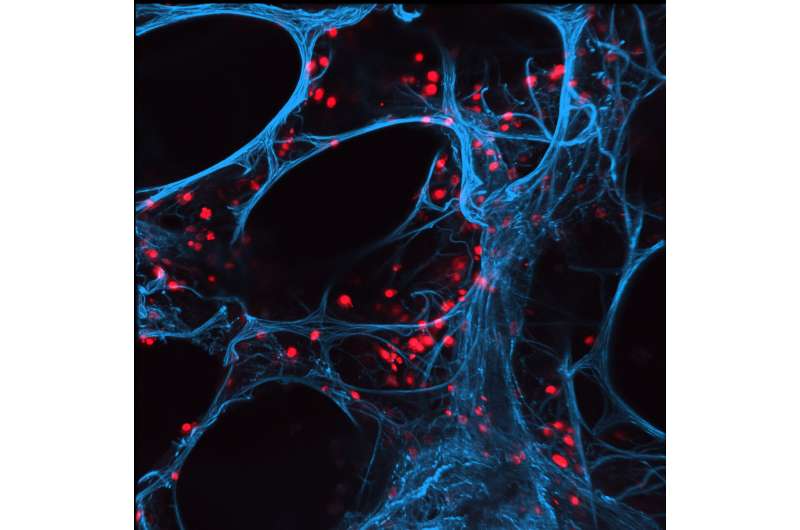Fighting infections and resistances

Winter is influenza season. In the northern hemisphere, cases of this infectious disease peak between November and March, and fatalities are not uncommon. Influenza vaccines can protect against the illness, but they aren't always effective. According to the Robert Koch Institute, the vaccines for 2018/2019 were only about 20 percent effective. In the iCAIR project, Fraunhofer researchers are collaborating with partners to develop new, urgently needed agents against influenza, as well as against other infectious diseases that are gaining ground worldwide. What is particularly interesting here is that the research team at the Fraunhofer Institute for Toxicology and Experimental Medicine ITEM can test the anti-infective agents in vital human lung slices.
Sudden high fever, chills, sore throat, headache, aching limbs—all these symptoms can be signs of an illness caused by the influenza virus. Seasonal flu vaccines are the best protection against infection, but they aren't always effective, as influenza viruses rapidly develop new mutations that the immune system doesn't recognize. In addition, influenza viruses are already partially resistant to neuraminidase inhibitors—antiviral agents that are used to treat this respiratory disease. Another problem is that flu makes patients more susceptible to secondary bacterial infections. Once they've been weakened by the viral infection, they're more susceptible to other pathogens. Most fatalities are not the result of the virus itself, but of a bacterial infection that accompanies an attack of influenza. Like other anti-infectives, antibiotics that were once effective are increasingly becoming ineffective against multiresistant bacteria.
This is where the iCAIR (Fraunhofer International Consortium for Anti-Infective Research) project comes in: researchers from Fraunhofer ITEM, in cooperation with the Hannover Medical School and the Institute for Glycomics at Griffith University in Australia, are developing new anti-infective agents and treatment approaches, in particular for the influenza virus, the parainfluenza virus, the bacteria Pseudomonas aeruginosa and Neisseria meningitidis, as well as for the fungus Aspergillus fumigatus. The consortium aims to get new active substances from the lab to the preclinical phase as quickly as possible. There is currently a gap in the development chain between the discovery of new substances and their development into useful drugs. "This area is being neglected, the pharmaceutical industry has largely withdrawn from the high-risk business of research and development. Fraunhofer is taking action, bringing together interdisciplinary basic research and high-level preclinical research," says Dr. Jana Führing, researcher at Fraunhofer ITEM.
The partners in the iCAIR research project are addressing this issue with a development platform they established themselves. The research alliance pools its expertise and unites a broad spectrum of methods—from drug candidate identification, drug design and efficacy testing to preclinical data generation and toxicological studies.

Using human lung slices to study infection in human tissue
Fraunhofer ITEM has established special test systems for efficacy testing of drug candidates: the researchers use vital tissue slices obtained from human lungs or parts of lungs—for instance following a tumor operation. They use these precision-cut lung slices—PCLS for short—to develop infection models with bacteria and viruses that enable them to study the processes directly in human lung tissue. This provides insights that make it possible to predict with the greatest possible accuracy what actually happens in humans. "PCLS help us better understand how viruses and bacteria behave in lung tissue and interact with our immune system. In addition, they allow us to test the efficacy of new substances," says the biochemist. "For example, there are already strains of influenza viruses that display resistances to the flu remedy Tamiflu. Our colleagues at the Institute for Glycomics in Australia are successfully developing agents against influenza and we test them here directly in human PCLS."
Initial preclinical proof of efficacy has already been provided. "We have shown that we can use PCLS to reproduce the infection of human lung tissue with the influenza virus. We have tested promising drug candidates from our Australian iCAIR partners, which reduce the amount of virus because the virus can no longer spread that well," says Führing. The drug candidates are currently undergoing further optimization. The iCAIR consortium's long-term objectives are to use the new methods of targeted compound development and testing to create a paradigm shift in the research for new anti-infectives and to make its research and development platform available to external partners.

















